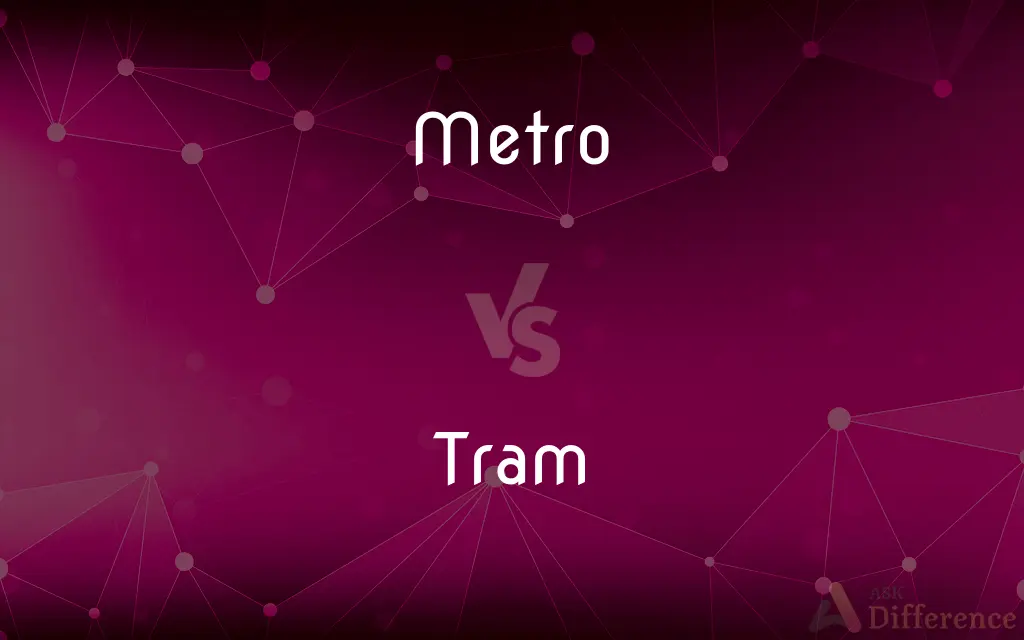Metro vs. Tram — What's the Difference?
Edited by Tayyaba Rehman — By Fiza Rafique — Updated on March 8, 2024
Metro is an urban rapid transit system operating mostly underground, while tram is a rail vehicle running on city streets or suburban areas.

Difference Between Metro and Tram
Table of Contents
ADVERTISEMENT
Key Differences
Metro systems, also known as subways or undergrounds, provide fast, high-capacity transportation within cities, typically operating on exclusive, grade-separated tracks to avoid street traffic. Trams, on the other hand, often share road space with other vehicles and pedestrians, running on tracks embedded in city streets, and are designed for shorter distances with more frequent stops compared to metros.
While metros are characterized by their ability to carry a large number of passengers quickly over long distances with fewer stops, trams excel in accessibility and integration with the urban environment, offering stops at closer intervals which make them ideal for short to medium distances within or between neighborhoods.
Metros require significant investment in infrastructure, including tunnels, elevated tracks, and stations, making them a more expensive option both in terms of construction and operation. Trams, however, are generally less costly to build and operate, due to the simpler construction of surface tracks and the use of existing road networks.
The operational speed of metros is typically higher than that of trams, as metros do not have to deal with road traffic and can therefore maintain a consistent speed between stations. Trams, while slower, provide the advantage of direct connections to destinations within city centers, often making them a preferred choice for shorter journeys.
From an urban planning perspective, metros are often part of a larger mass transit strategy to reduce congestion and improve mobility in densely populated areas. Trams are seen as a complementary mode of transportation, enhancing connectivity and accessibility within cities, and contributing to sustainable urban development by encouraging public transport use over private vehicles.
ADVERTISEMENT
Comparison Chart
Environment
Mostly underground or elevated.
Operates on city streets or suburban areas.
Capacity
High-capacity, designed for long distances.
Lower capacity, suited for shorter distances.
Infrastructure
Requires extensive, costly infrastructure.
Less expensive, uses existing roads.
Speed
High speed, avoids traffic.
Slower, shares space with traffic.
Stops
Fewer stops, spaced further apart.
Frequent stops, closer together.
Urban Integration
Separate from urban traffic.
Integrated within the urban landscape.
Cost
Higher construction and operation costs.
Generally lower costs.
Purpose
Reduces congestion, serves densely populated areas.
Enhances city connectivity and accessibility.
Compare with Definitions
Metro
Rapid urban transit.
The New York City subway serves millions daily.
Tram
Accessible urban transport.
Zurich's trams offer stops throughout the city.
Metro
Serves large urban areas.
The London Underground connects diverse neighborhoods.
Tram
Street-level rail service.
Melbourne's trams enhance city mobility.
Metro
Focus on speed and capacity.
Beijing's metro system is designed for efficiency.
Tram
Lower cost of implementation.
New tram lines in Bordeaux revitalized transportation.
Metro
Operates independently of traffic.
Tokyo's metro offers timely commutes.
Tram
Shares space with traffic.
Amsterdam trams navigate through busy streets.
Metro
High investment in infrastructure.
Paris metro expansion requires significant funding.
Tram
Suited for shorter distances.
Trams in Prague provide convenient local transit.
Metro
(general) A rapid transit rail transport system, or a train in such systems, generally underground and serving a metropolitan area.
Tram
A tram (in North America streetcar or trolley) is a train that runs on tramway track on public urban streets; some include segments of segregated right-of-way. The lines or networks operated by tramcars as public transport are called tramways or simply tram/streetcar.
Metro
(less common) An urban rapid transit rail transport system, normally with lighter track and light trains (i.e. an S-Bahn or similar), or a train in such systems.
Tram
A streetcar.
Metro
A metropolitan area.
Tram
A streetcar line.
Metro
Metropolitan
Tram
A cable car, especially one that rolls along an overhead cable along which it is drawn by a second, moving cable.
Metro
Electric underground railway
Tram
A four-wheeled, open, box-shaped wagon or car run on tracks in a mine.
Tram
An instrument for gauging and adjusting machine parts; a trammel.
Tram
Accurate mechanical adjustment
The device is in tram.
Tram
A shiny silk thread with very little twist, primarily used as a weft yarn.
Tram
To move or convey in a tram.
Tram
To adjust or align (mechanical parts) with a trammel.
Tram
A passenger vehicle for public use that runs on tracks in the road (called a streetcar or trolley in North America).
Tram
A similar vehicle for carrying materials.
Tram
A people mover.
Tram
(US) An aerial cable car.
Tram
(US) A train with wheels that runs on a road; a trackless train.
Tram
A car on a horse railway or tramway (horse trams preceded electric trams).
Tram
(obsolete) The shaft of a cart.
Tram
(obsolete) One of the rails of a tramway.
Tram
(weaving) A silk thread formed of two or more threads twisted together, used especially for the weft, or cross threads, of the best quality of velvets and silk goods.
Tram
(intransitive) To operate, or conduct the business of, a tramway.
Tram
(intransitive) To travel by tram.
Tram
(transitive) To transport (material) by tram.
Tram
To align a component in mechanical engineering or metalworking, particularly the head of a drill press.
Tram
(weaving) To weave in this manner.
Tram
A four-wheeled truck running on rails, and used in a mine, as for carrying coal or ore.
Tram
The shaft of a cart.
Tram
One of the rails of a tramway.
Tram
A car on a horse railroad.
Tram
A silk thread formed of two or more threads twisted together, used especially for the weft, or cross threads, of the best quality of velvets and silk goods.
Tram
To convey or transport on a tramway or on a tram car.
Tram
To operate, or conduct the business of, a tramway; to travel by tramway.
Tram
A conveyance that transports passengers or freight in carriers suspended from cables and supported by a series of towers
Tram
A four-wheeled wagon that runs on tracks in a mine;
A tramcar carries coal out of a coal mine
Tram
A wheeled vehicle that runs on rails and is propelled by electricity;
`tram' and `tramcar' are British terms
Common Curiosities
How do metros and trams differ in terms of infrastructure?
Metros require extensive and costly infrastructure, including tunnels and elevated tracks, while trams typically use existing roadways with less significant additional infrastructure.
Why might a city choose to develop a tram system instead of a metro?
A city might opt for a tram system due to lower costs, the need for street-level connectivity, or the suitability of trams for shorter distances with frequent stops.
What is a metro?
A metro is a high-capacity urban rapid transit system, usually operating on exclusive tracks and often underground, designed to move large numbers of people quickly across cities.
Are trams considered safer than buses?
Trams can be considered safer in some contexts due to their dedicated tracks and predictable paths, but safety also depends on proper infrastructure, vehicle design, and operational practices.
What role do metros play in urban planning?
Metros help reduce urban congestion, improve mobility in densely populated areas, and are a key component of sustainable urban development strategies.
How do trams contribute to urban sustainability?
Trams contribute to urban sustainability by encouraging public transport use over private vehicles, reducing traffic congestion, and enhancing the accessibility of urban areas.
What is a tram?
A tram is a rail vehicle that runs on tracks along public urban streets and sometimes on separate rights of way, providing frequent stops and is intended for shorter distances.
Which is faster, metro or tram?
Metros are generally faster because they operate on separate tracks away from street traffic, whereas trams are slower due to sharing space with other vehicles and pedestrians.
How do weather conditions affect trams and metros?
Metros are largely unaffected by weather due to their underground or elevated tracks, while trams, operating on street level, can be impacted by severe weather conditions.
Can trams and metros be part of the same public transportation network?
Yes, trams and metros can complement each other within a city's public transportation network, with trams enhancing local connectivity and metros providing rapid transit across longer distances.
Share Your Discovery

Previous Comparison
Lophotrochozoa vs. Ecdysozoa
Next Comparison
Disciple vs. StudentAuthor Spotlight
Written by
Fiza RafiqueFiza Rafique is a skilled content writer at AskDifference.com, where she meticulously refines and enhances written pieces. Drawing from her vast editorial expertise, Fiza ensures clarity, accuracy, and precision in every article. Passionate about language, she continually seeks to elevate the quality of content for readers worldwide.
Edited by
Tayyaba RehmanTayyaba Rehman is a distinguished writer, currently serving as a primary contributor to askdifference.com. As a researcher in semantics and etymology, Tayyaba's passion for the complexity of languages and their distinctions has found a perfect home on the platform. Tayyaba delves into the intricacies of language, distinguishing between commonly confused words and phrases, thereby providing clarity for readers worldwide.














































